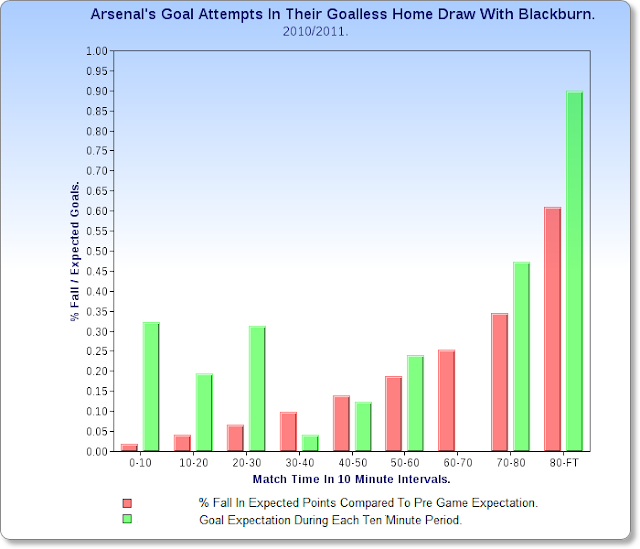The aim is to add context to a team's season long figures and possibly identify individual traits which may define tactical approaches to gaining and maintaining a lead, which otherwise may remain hidden among a variety of different styles. Accurate passing over short distnces is a desired aim of lots of sides, but not all.
In the previous post I looked at how Arsenal become slightly more enamoured with the long, hopeful ball when the game state consistently refuses to turn in their direction. By comparison, Stoke, the leading exponents of long ball football in recent times, are such extreme practitioners of the art that they have nowhere else to go and leave this part of their gameplan virtually unchanged regardless of game states.
I've further looked at pass direction comparisons between these two diametrically opposed sides to see how game state changes the proportion of "negative" backwards and sideways passes each side attempts. I've simply labelled the x axis as progressing from poor to good game states.
To obtain such a strong correlation when examining game by game data, where random variation exists is unusual and the trend, if not the direction of causation appears clear. Arsenal are playing proportionally more forward passes when they have spent a good portion of the match chasing a poor game state. When they have enjoyed lots of positive game states over the 90 minutes, their proportion of backwards or sideways passing has consistently been higher. Possibly indicting a change to a risk averse strategy based on ball retention.
Inevitably, Stoke produce a plot with the opposite slope. They appear to use forward passes (often long) to gain a lead and similar tactics to protect one, by getting the ball as far away from their own danger area as possible. It is only when they are behind expectations and opponents set up to defend that they accrue time and opportunity to play football that involves typically patient build up play.
It is a trait Stoke shared with another struggling side in QPR. Like the Potters QPR only really found the time and space to play, thoughtful probing football when their opponents were content to allow them to.
Most on field actions I've looked at involve some teams taking diametrically opposed approaches to other teams, (making the search to value such metrics equally for all teams slightly futile), but the proportion of shots a side has in a single game invariably follows the same direction for all teams. In short, as a team increases their share of shots in a single game, the more likely they were to have enjoyed better game states.
If you wanted to get Manchester United on the ropes in 2011/12, you had to outshoot them and that inevitably meant you had to be a fellow title contender. The influence of random variation is shown by the outlier relating to 70% of the shots, yet continually poor games states during the 3-2 home defeat to Blackburn.
Liverpool share the plot direction with United, but unlike United, they appeared more dominant in rarely failing to win the shooting battle, yet still found themselves facing poor game states. In a previous post Liverpool were flagged up as being more willing to shoot from distance and an increased number of speculative, low probability shots when trailing or drawing may explain the curve.
There is one interesting outlier in on Liverpool's graph. They barely managed a shot compared Spurs in the latter's 4-0 early season win and ended up facing predictably poor game states. The point should appear even further to the left than it does and if we had accounted for Liverpool's two red cards, that is where it would move. Red cards, a reasonably common occurrence, shift game states, so ideally they should be accounted for.
 |
| Stoke look to cut out a pass into the final 3rd. |
I've flipped the x axis to prevent the need for some messy recalculation, so a predominately good game state for Wolves appears on the extreme left in this plot. The case for final third completion rates is well made, the more opponents completed their passes and the more Wolves failed to get a toe in, the worse things got and remained so for the soon to be relegated for a second time team from the West Midlands.
I've quickly realised where to look to see if any of these correlations are likely to be universal across all teams and supporters of the final third completion stat will be happy to know that Stoke and Arsenal also follow Wolves' lead here.












